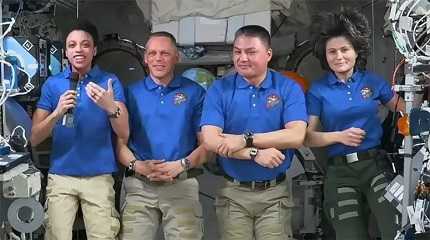
JACKSONVILLE (Florida, US), Oct 16 (NNN-XINHUA/AGENCIES) — NASA’s SpaceX Crew-4 astronauts aboard the Dragon spacecraft safely splashed down off the coast of the southeastern U.S. state of Florida on Friday, NASA said.
The four-member international crew, consisting of NASA astronauts Kjell Lindgren, Bob Hines, Jessica Watkins and European Space Agency astronaut Samantha Cristoforetti, returned to Earth in a parachute-assisted splashdown at 4:55 p.m. Eastern Day Time.
“Welcome home Crew-4! This international crew has spent nearly six months on the International Space Station conducting science for the benefit of all. Their work aboard the orbiting laboratory will help prepare future explorers for future space missions,” said NASA Administrator Bill Nelson.
“Working and living on the space station is the opportunity of a lifetime, but it also requires these explorers to make sacrifices, especially time away from loved ones. Kjell, Bob, Jessica, and Samantha, thank you for your contributions over the past six months to science, innovation, and discovery!”
The Crew-4 mission launched at 3:52 a.m. EDT on April 27 on a SpaceX Falcon 9 rocket from NASA’s Kennedy Space Center in Florida. Less than 16 hours later, Dragon docked to the Harmony module’s space-facing port. The astronauts undocked from the same port at 12:05 p.m. Friday, to begin the trip home.
Throughout their mission, the Crew-4 astronauts contributed to a host of science and maintenance activities and technology demonstrations. Cristoforetti completed two spacewalks with Roscosmos cosmonaut Oleg Artemyev to perform station maintenance and upgrades.
The Crew-4 flight is part of NASA’s Commercial Crew Program and its return to Earth follows on the heels of NASA’s SpaceX Crew-5 launch, which docked to the station Oct. 6, beginning another science expedition.
The goal of NASA’s Commercial Crew Program is safe, reliable, and cost-effective transportation to and from the International Space Station. This already has provided additional research time and has increased the opportunity for discovery aboard humanity’s microgravity testbed for exploration, including helping NASA prepare for human exploration of the Moon and Mars.




